Archive for July 2018
Blueberry Rhubarb Cobbler Inspired By Chez Panisse Recipe: Low Sugar & Easy to Make
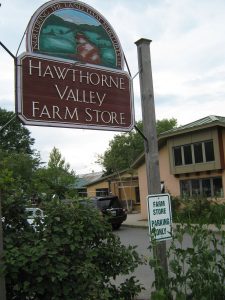
The search for local and organic blueberries began at the wonderful Hawthorne Valley Farm Store in Ghent (Columbia County), NY, which had a few containers of “ecologically grown” blueberries from Pumpkin Hill Farm in Hillsdale (Columbia County), NY

The Berry Farm in Chatham (Columbia County), NY had its own “no spray, pesticide free” blueberries available at a reasonably priced $7.99 per quart
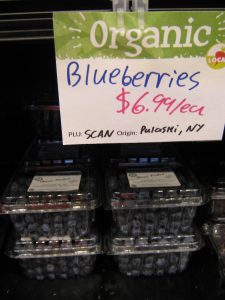
My home-town food co-op, Honest Weight in Albany, NY, had a few containers of Certified Organic, Hand Picked blueberries from Grindstone Farm in Pulaski (Oswego County). NY
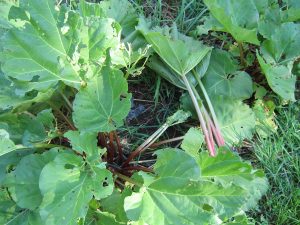
Easy picking of organically grown rhubarb from my backyard garden patch, which has remained productive into the heat of summer

The best ingredients for a blueberry rhubarb cobbler: organic & local blueberries and rhubarb from the backyard garden
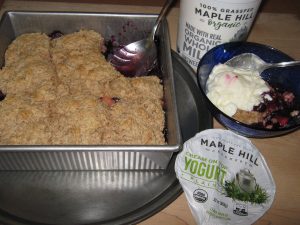
Out of the oven and ready to enjoy: a dish of blueberry rhubarb cobbler, with a topping of Maple Hill yogurt (made from milk of 100% grass-fed cows)
A few weeks ago, in a Here to Help column appearing in the New York Times, Molly O’Neill shared a recipe for Chez Panisse’s Blueberry Cobbler. O’Neill noted that the recipe prizes the berries above all, using only 1/3 cup of sugar. A blueberry cobbler from the kitchens of Chez Panisse, the mother of all farm to table restaurants opened by food activist Alice Waters in 1971, is an irresistible dessert in mid July when local blueberries are becoming available. The Wikipedia page on the Berkeley, CA Chez Panisse sums up the importance of this restaurant which focuses on ingredients rather than technique and has developed a supply network of direct relationships with local farmers, ranchers and dairies.
Although conventional blueberries do not appear on the Environmental Working Group’s list of the dirty dozen, on the group’s full list blueberries are shown as number 15. No surprise then, that for our blueberry rhubarb cobbler, local and organic blueberries would be the main ingredient in preparing our summertime dessert.
Last summer, we shared a recipe for Oatmeal Strawberry Squares from Beatrice Trum Hunter’s trail-blazing The Natural Foods Cookbook from 1961 and noted the difficult quest to find local and organic strawberries. Our hunt for local and organic blueberries took less effort since we could retrace our path from last summer’s hunt for strawberries. And much easier, was harvesting some stalks of rhubarb from a backyard garden to use in our variation on the Chez Panisse recipe.
In addition to substituting a cup of rhubarb (to accent the sweet with a complementary tart flavor) for one cup of fresh blueberries in the original Chez Panisse recipe, instead of using 3/4 cup of heavy cream, our recipe substitutes 3/4 cup of kefir milk. Another variation, since our recipe uses a cup of sliced-up rhubarb, a slightly longer baking time of 40 to 45 minutes is needed to ensure that the rhubarb becomes tender, instead of 35 to 40 minutes if only blueberries are used.
This local and organic food advocate almost always avoids using added sugar, and although tempted to substitute local maple syrup or local honey, for this recipe I broke my rule and used Jedwards Fair Trade Certified Organic sugar, available in the bulk food section of my hometown food co-op, the Honest Weight in Albany, NY.
Blueberry Rhubarb Cobbler (Makes 4-6 servings)
The Berries & Rhubarb
3 1/2 cups fresh blueberries
1 cup of rhubarb (sliced into 1/4 inch pieces)
1/3 cup sugar
1 tablespoon all-purpose flour
The Dough
1 1/2 cups all-purpose flour
1 1/2 tablespoons sugar
2 1/4 teaspoons baking powder
1/2 teaspoon sea salt
3/4 cup kefir milk
6 tablespoons cold unsalted butter, cut into 1/2 inch pieces
Heat the oven to 375 degrees.
To prepare the blueberries and rhubarb, place in a bowl the blueberries and sliced-up rhubarb and toss with the sugar and flour. Set aside.
To make the dough, mix the flour, salt, sugar and baking powder in a bowl. [I used all-purpose, organic whole wheat flour from Farmer Ground Flour in Trumansburg (Tompkins County, NY).] Cut in the butter until mixture resembles coarse meal. [I used Kriemhild Meadow butter made with milk from the Hamilton (Madison County, NY) dairy farm’s grass-fed cows.] Add the kefir milk and mix lightly, just until the dry ingredients are moistened.
Put the blueberries and rhubarb in a 1 1/2-quart baking dish or pan.
Make patties out of the dough, 2 to 2 1/2 inches in diameter and 1/2 inch thick. Arrange them over the top of the berries and rhubarb.
Bake until the topping is brown and the juices bubble thickly around it, about 40 to 45 minutes.
Let cool slightly.
Serve warm, with yogurt or cream or vanilla ice-cream, if desired.
(Frank W. Barrie, 7/23/18)
Superb Dining At Lansing Farm’s Field Notes In Upstate NY’s Capital Region

Red leaf lettuce with grilled peaches and focaccia croutons tossed in a blueberry vinaigrette: a perfect salad course

Pork cooked sous vide has a robust sweetness helped along by a sauce of cherries in brown butter, accompanied by spinach sautéed with almonds and grated potatoes, also sautéed
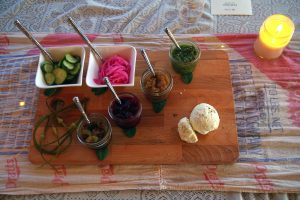
A very flavorful cheese course included accompanying basil pesto, onion jam, chutney of pickled green tomatoes and a currant-cherry IPA jelly

Chef Kyle MacPherson, along with chef Joan Porambo, deserve much praise for bringing superb farm to table dining to the Capital District of upstate NY
Had I wanted more food, I probably could have strolled into the fields just beyond the dining area and helped myself. But that would have meant bypassing the creative, harmonious transformations effected by chefs Joan Porambo and Kyle MacPherson. They’re offering brunches and dinners (they call their farm to table meals Field Notes) at the Lansing Farm on Lishakill Road in Colonie (Albany County) in upstate New York.
The farm market on the premises has been a longtime reason for visiting; picking up your CSA shares is another. Al Lansing is an eighth-generation farmer, and his kids are extending that statistic – which dates back to the original settlers of the once-rural area, but now leaves him running the only remaining farm in this much-transformed suburban town.
It was Al’s idea to do these dinners, says Joan, who speaks with an eagerness that reveals her own enthusiasm but also is a reminder that she’s still got dinners to prepare and serve. Thanks to some family connections, Lansing met with the chefs and persuaded them to relocate from the Stowe, Vermont, restaurants where they were working and create an event that would feature dining on Lansing Farm’s produce, a short walk from the fields and greenhouses where it was grown.
It’s the first dinner of the season, and we visit on a perfect summer evening, with the sun easing behind a greenhouse throughout the course of our meal. The farm greets its visitors with a market building, while the dinner tent sits off to one side. A refectory table salvaged from the historic Yorktowne Hotel (York, PA) is draped in linen and burlap, the latter a series of repurposed bags offering a decorative highlight. It’s set for six, but Joan shrugs off the disappointment. The first time we did this – which took place last summer – only two people showed up. But the table accommodates twenty, and last year that number was reached.
Iced tea – courtesy Divinitea in Halfmoon (Saratoga County, NY) – is available at a pour-it-yourself station. Sinatra sings uptempo standards in the background. Both chefs welcome the arriving guests, taking turns keeping what’s happening in the kitchen underway.
What’s happening is an amuse-bouche platter, a ritual that kicks off each such meal. Today it’s fried brioche with onion jam and a note of plums; alongside it, tempura of squash blossoms with a dab of aioli and decor of chive blossoms.
This is walking-around food, toothsome morsels that help break the ice as you prepare to share what’s to come. We work with what’s coming in, Joan says. Right now, the greenhouse tomatoes are ripe, so we picked the freshest and newest ones and roasted them with garlic and cream. It’s the first course, a rich soup served in small, handsome bowls, each pumpkin-colored serving topped with a dollop of garlic scape pistou.
Scapes are one of the high points of the early-summer harvest, plucked from the garlic plant before it can flower, a string bean-like item with built-in seasoning. As a tomato accompaniment, it’s perfect. And it soon will reappear in another guise.
Joan is the Sinatra fan. She grew up in Jim Thorpe, PA, and discovered her passion for cooking while preparing meals and desserts for her family – and sharing the enjoyment of the music they like. After graduating from the Culinary Institute of America in 2012, she went to work for Ric Orlando at New World Bistro Bar in Albany, making her way from there to Prohibition Pig in Waterbury, VT, before returning to the Capital Region of upstate New York.
Kyle, meanwhile, grew up in New Hampshire and graduated from the New England Culinary Institute in 2005, after which he worked in Boston before becoming executive chef of the Cliff House at Stowe Resort. But working at Lansing Farm allows him to see, touch, interact and appreciate the produce in real time as it’s grown, which only increases the creative potential of these items.
Greens are at a peak, and they look beautiful, says Joan, introducing the next course, which features red leaf lettuce with grilled peaches and focaccia croutons, tossed in a blueberry vinaigrette for balanced acidity. I love making focaccia, so that’s fun to use for the salad, and it also has a sprinkling of marigold petals to add a slight bitterness. Eating a delicious salad while gazing at its fields of origin feels right – indulgently right, making peace with Nature right. And, of course, it tastes fresher than anything from the market.
One of the guests brought a bottle of wine – that’s the only way to enjoy strong waters at these events for now – and we sipped in anticipation of the entrée. Our salad plates were cleared and the silver was reset. No need to save your fork, and the reset ritual, as Joan observes, acts as a buffer between courses and makes a formal dinner seem less intimidating.
Kyle presented the next course, and it was impressive. The pork, while not from Lansing Farm, was close enough: it’s one of the hormone-free meats raised and sold by Smith’s Orchard in Ballston Spa (Saratoga County, NY). It was cooked sous vide, which is the process of simmering an item (which is sealed in a bag) in a liquid at the desired finish temperature for the time it takes to reach that temperature. It guarantees no loss of flavor or moisture, and the pork’s robust sweetness practically leaped to the palate, helped along by a sauce of cherries in brown butter. Whatever your feeling about spinach, when it’s freshly harvested and sautéed with almonds, it’s like dessert. And it’s a traditional accompaniment to the Swiss dish rösti, so it was appropriate to see that green, leafy (and nutritious) vegetable alongside the coarsely grated potatoes, parboiled and then sautéed – in cast iron, Kyle explained, with pork fat. Any questions? Not from this diner, just culinary satisfaction.
A cheese course always follows the entrée, and this evening’s farm cheese was made from Battenkill Valley Creamery’s milk. [Battenkill Valley Creamery is a dairy business founded by Donald and Seth McEachron, 4th and 5th generation farmers, respectively, who began processing and bottling milk on their family farm in Salem (Washington County), NY in 2008.] The result is a fresh, pleasant confection that begs for strong-flavored accompaniment, and that’s exactly what it got. Scapes returned to the table, now pickled, alongside pickled red onion and traditional cucumber pickles. And four small jars of a wonderful variety of piquant concoctions: basil pesto with walnuts, a chutney of pickled green tomato, a currant-cherry IPA jelly with robust sweetness, and an onion jam that’s the result of two hours of cooking the stuff in maple syrup. Served with a generous mound of baguette slices, we passed the board around the table trying to pace our caloric intake.
The cheese board stays on the table through dessert, so you can get back to the delicious onion jam (I certainly did), but we paused to make short work of a strawberry pot de crème that boasted just enough tartness to be a good companion to a sweet almond lace cookie. Someone nearby began setting off fireworks, a perfect way to celebrate a meal like this.
Field Notes has added a brunch to the proceedings this summer, and you can view menus and make reservations through their website. And don’t be dismayed if the weather looks lousy: the tent already has withstood inclemency, though in this hot, dry summer, rain seems unlikely though much needed by farmers and gardeners.
Dinners are one seating at 7 PM Saturdays for $65 per person; brunch is a la carte Sundays and runs from 11 to 3. You can also sample chefs Joan Porambo and Kyle Macpherson’s cooking at the Troy Farmer’s Market Saturdays from 9 AM-2 PM, and Tuesdays from 6-9 PM at Rare Form Brewing Company, also in Troy (Rensselaer County), NY. Field Notes at Lansing Farm, 204 Lisha Kill Road, Colonie (Albany County), 802.503.9670, Dinner: one seating at 7 PM Saturdays for $65 per person, Brunch is a la carte Sundays and runs from 11:00AM-3:00PM, www.fieldnotes-ny.com.
(B.A. Nilsson, 7/16/18)
[Editor’s Note (FWB): Field Notes at Lansing Farm is one of 75 listings included in this website’s very special directory for dining on the farm or in the garden, with listings in the United States, Canada, Australia, Denmark, England, Ireland, Sweden & Wales!]
Nature’s Path, Business Winner of Rodale’s 2018 Organic Pioneer Award, Resigns In Protest From The Organic Trade Association
Last month, we reported on the Rodale Institute’s Organic Pioneer Awards for 2018 honoring peach farmer Mas Masumoto, research scientist William Liebhardt, and North America’s largest organic breakfast company, Nature’s Path. This business, founded by Arran and Ratana Stephens and still family-owned, has recently announced its resignation from the Organic Trade Association (OTA).
According to a press release issued by the company, OTA has shifted its commitment from supporting and representing the core principles of the organic food movement to begin pushing a non-organic agenda which threatens the future of organic. The Wikipedia page for the Organic Trade Association sums up criticism of the OTA. Citing the Organic Consumers Association and The Cornucopia Institute (Cornucopia), OTA is viewed by many as an agent of big business interests working to undermine the credibility of the organic movement.
Similarly, Arran Stephens, Nature’s Path co-CEO, in explaining his company’s resignation from the OTA, noted that giant food corporations, that also happen to own small organic brands, use the OTA to influence policy decisions to protect the best interest of their large non-organic food portfolios. In particular, Stephens points to OTA’s allowing hydroponics to fall under the organic certification label where there is no organic agriculture nor soil present and its support for a vague and misleading national GMO labelling law. (A compelling slogan on Nature’s Path home page is Get Goodness, Not Glyphosates in noting that its organic oats give you all the good stuff and none of the toxins, like glyphosate, in your bowl of granola.)
Mark A. Kastel, Senior Farm Policy Analyst at Wisconsin-based Cornucopia, a nonprofit which acts as a governmental and corporate watchdog in the organic industry, sharing Stephens’ concerns, notes that When there are billions of dollars at stake, time and time again, the OTA has sided with conventional agribusiness interested in liberalizing the working definition of organics. Allowing plants grown in liquid fertilizers to be considered organic, despite the clear requirement in the Organic Foods Production Act that soil fertility (the historic basis for organic plant nutrition) must be maintained or improved, is being legally challenged by Cornucopia.
(Frank W. Barrie, 7/10/18)
It’s Time To Know About the World’s Tiniest Grain: Teff

The extraordinary Honest Weight Food Co-op in Albany, NY with its nearly 1000 bins of bulk food offers both brown and ivory teff flours
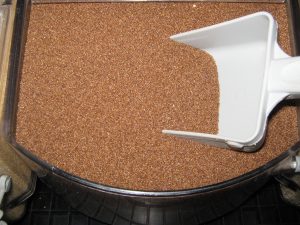
Teff grain is also available at Honest Weight’s bulk food department
Acres magazine is published monthly by Acres U.S.A., which was established back in 1971. This monthly magazine, known as the Voice of Eco-Agriculture, carries these pithy words of its founder Charles Walters (1926-2009) on its masthead: To be economical, agriculture must be ecological. For more than four decades, the magazine has sought to help farmers, ranchers and market gardeners grow food organically, sustainably, without harmful, toxic chemistry.
Each issue of the magazine is worthy of a careful reading. In a recent issue, a profile of Tenera Grains in Addison (Lenawee County), Michigan caught our eye. Brad and Diane Smith decided a few years ago, when corn prices slumped, to diversify their crops grown on their seventh-generation crop farm. A friend from Ethiopia suggested that they might try growing the world’s tiniest grain teff. The cultivation of teff is believed to have begun between 4,000-1,000 B.C.E. in Ethiopia and Eritrea.
The Oldways Whole Grains Council notes in an article on Tenera Grains, that just one handful of teff seeds is enough to plant an acre and that it can grow from sea level to as high as 3000 meters of altitude and can withstand both droughts and waterlogged soil conditions. It seems likely that this resilient crop will become much more important as effects of global warming become more pronounced.
And the reliable and go-to cookbook, Joy of Cooking by Irma S. Rombauer, Marion Rombauer Becker, and Ethan Becker (New York, NY: Scribner, 1997), sings the praises of this flavorful staple grain of Ethiopia, where it is turned into a spongy flat bread called injera: It smells like molasses while cooking, and if mixed with butter, it tastes like cake. Only the size of celery seeds, the iron-rich kernels have a high surface-to center ratio, which makes them high in fiber.
In the United States, teff is sold as a flour, in a pasta, and as a whole grain. This website’s directory of artisanal grains and flours, not part of the commodity grain trade, has three listings of sources of teff for the consumer market: (i) teff flour from Grist and Toll, based in Pasadena, California, (ii) brown teff flour from Camas Country Mill based in Junction City, Oregon; and (iii) brown and ivory teff flours and Teffola, a nutty teff granola, from Tenera Grains in Addison, Michigan.
We recently received word from Diane Smith that Tenera Grains is currently selling their teff flour on Amazon (search Tenera Grains). And she has plans to find additional sources for buckwheat and rolled oats in order to produce her popular Teffola, a nutty teff granola. (Growers of organic buckwheat and rolled oats who see this post should contact Tenera Grains.)
The cookbook Joy of Cooking also includes a creative suggestion from food writer Nao Hauser to cook up the teff grain into a porridge (with three parts water to one part grain), and then spreading it into a baking pan while warm, refrigerate, cut into slices or triangles and bake or fry like polenta toast.
(Frank W. Barrie, July 3, 2018)









